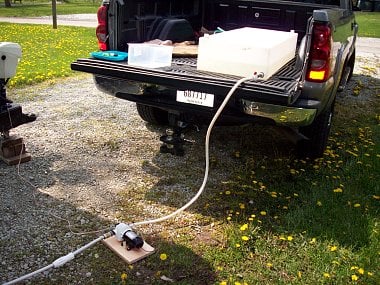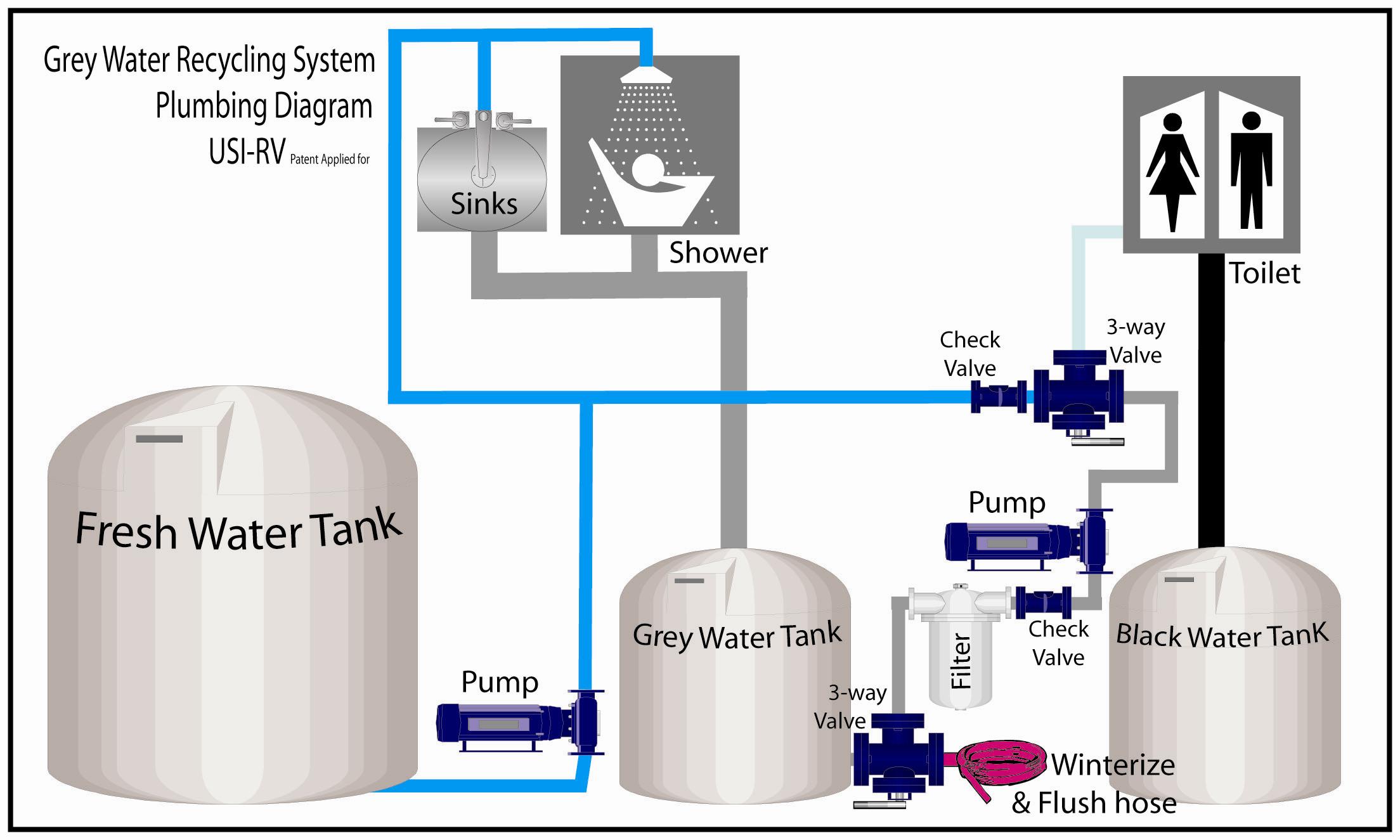Every RVer who enjoys dry camping understands the tricky nature of balancing the amount of fresh and grey water that gets put into holding tanks on a camping trip. Being forced to make a trip to the dump station and replenish fresh water supplies is an annoyance that we try to avoid but sometimes even the most conservative water usage can’t prevent this kind of disruption.

Thanks to a RV grey water recycling system developed by Greg Corwin, founder of Chicago-based USI RV, now we can all spend more time camping and less time dumping. Here’s how his grey water recycling system works:

Corwin has created the Extend Your Stay Tank Saver Kit, a DIY grey water recycling system for RVs of all sizes that uses a secondary water pump to move used kitchen and bathing water out of your grey water holding tank, through a filtration system and finally into your toilet for flushing water. For those times when you’re enjoying the convenience of full-hookups, a lever placed near the toilet allows you to easily return to non-recycling mode.

By using filtered grey water in the toilet, you’re:
- Saving fresh water for better uses, like drinking
- Reducing inflow into your grey water holding tank
- Extending your dry camping days by avoiding a dump station trip
What the Kit Includes
The Extend Your Stay Tank Saver Kit is a collection of about 60 standard and hard-to-find parts that comprise Greg’s engineered and tested grey water recycling system. For $275 you’ll have access to the parts, a detailed step-by-step installation manual and any customer support you need from Greg himself. This price doesn’t include the secondary water pump, but to get more efficiency out of your entire fresh and grey water system, Corwin recommends reassigning your existing water pump to this system and purchasing a newer, better pump for your main house needs.
USI assures buyers that anyone who can operate a drill can install this system, but a little mechanical aptitude can definitely reduce the amount of time needed to complete the installation. Expect to set aside anywhere from two to four hours depending on your capabilities and knowledge about basic electrical connections, which you must perform in order to connect your new water pump to your system.
Worry-Free from Odors
Once installed you don’t need to worry about bacteria and odors coming from the recycled water. USI’s kit includes a premium carbon-wrapped filter that won’t restrict water flow but will help take away the particulates that can cause odors emitted from your grey water tanks. In addition, the implementation of good dry camping habits will also protect against that rotten egg smell. For example:
- Use a paper towel to clean all food debris from plates and cookware before washing in your sink.
- Purchase mesh drain covers to prevent large food particles from going down the drain.
- Only use your bathtub and sink for their intended purposes. All other waste should be put in the black tank through the toilet.
If you’re still skeptical about how this system will enhance your RV camping trips, you can purchase the company’s Gray Water Recycling Calculator, an inexpensive spreadsheet with embedded calculations that help you determine how much longer you can dry camp with this RV grey water recycling system once you input certain parameters like your dish washing frequency, daily toilet flushes, the number of people in the RV and more.
Better Camping, Cleaner Planet
RVers get quite creative when trying to boost fresh water tank capacity. With the Tank Saver system, you can skip the idea of adding a secondary water tank or bladder to your setup, and avoid touchy conversations about dumping grey water on the ground. Camping in the outback without hookups has never been easier and better for the environment.

To whom this may concern.
Our company name is Australian Off Road we are located in QLD Australia.
I am interested in your company grey water recycling product and wish to purchase a kit for testing.
We current build 12 to 13 off road caravans a month , approx. 150 per year. If the testing goes well we would place an order in for 25 to 30 kits every 2months.
Could you email us an invoice for one RV grey water recycling kit please -gary@australianoffroad.com.au
I will need the following information ,
-Transport pick up address
-Size of parcel
-weight
-Ph. number
-Contact
Note: AOR will be able to organise transport. (Door to door)
Once I receive the above information I will pass this information to our Purchasing manager Joe Daily and he will contact you as soon as possible.
Looking forward in doing Business with your company .
Kind Regards Gary Strid
AOR Business Improvements Manager
Hi Gary,
You can reach out to the company by visiting them at http://www.usi-rv.com/product.sc?productId=7&categoryId=2
Thanks for your interest.
This seems like nothing more than a scam. The parts are available, the technology is available, all that’s not common is the IDEA and the plumbing. Further, while the schematic of the system shows recycled water going back to sinks and shower, this page talks ONLY about flushing the toilet with recycled water.
I am currently in the demo and planning stages of a custom skoolie build into a Class A. A reclamation system is an integral part of our build but I certainly am not running it to sinks (potable required). It will be used for showers and washing machine and will EXCLUDE sink waters because of the food contaminants in kitchen sinks and high concentration of soaps and toothpaste in bath sinks.
It’s not difficult, it just takes proper screens/filters then an RO unit and finally a UV sterilizer.
Dude, this is a 7 year old article, and it looks like the source mentioned here no longer sells the product.
Best of luck with your own project, though.
Not a new idea, and if you’re at all handy, you probably already have done this or at least know how. I’m not dissing the man’s efforts, and would never fault someone for trying to make an honest buck. It’s not a scam but I won’t be paying $275 for this. To others, that price might sound like a bargain.
Bruce, I hope you realize RO creates 3 times the waste water that it produces potable water. I actually use RO at my kitchen sink and direct the waste it creates to the shower, and from there to the toilet. Yes, I don’t mind my shower water being the waste from RO, as it’s basically the same as what’s in the fresh water tank. I look at the RO as a way of separating the water I want to be clean from the water I don’t care so much about. The trick is finding the right balance of water consumption. You don’t want the RO generating more waste than you can use elsewhere, so you if the shower doesn’t consume enough, you can run use it to supply all hot water, etc.
That said, you seem to be talking about using RO on the grey water. That seems like it’s not going to work as you are hoping. Also, when you exclude the sinks, as a source and say you will use the reclaimed water for showers and wash, what then is the source? Are you planning to continually recycle the shower and wash water? Your filters will need to be changed daily. They aren’t meant for that level of contamination.
Perhaps I’ve missed something about the schematic for the grey water recycling system but…There appears to be no link between the grey water tank and the toilet in this diagram. Instead, it appears to be going back to the shower and sink systems. Hmmm……
Hey Andrew,
If you look at the diagram again there are blue lines that represent fresh water from the left tank. From the middle tank you see a grey line first to a three-way valve, to filter to pump to another three-way valve that then goes to the toilet. The second three-way valve allows you to choose between grey water or fresh water for your toilet.
I’m a little surprised not to see this more out there.
Ian
Ok, so this really just looks to be a way to use grey water to flush a toilet into a black water tank. Composting toilets are far better than to bother with black water and there’s no good way to recycle the grey water into the shower in this schematic. Fresh water is for priming the system to actually have grey water to recycle (first few shower/sink uses to get water into the grey water tank), but then you need to filter and UV the outlet of the grey water and send it back to the shower. This isn’t shown at all in this diagram, so it’s not what really useful unless you like flushing toilets into black water tanks. No thanks!